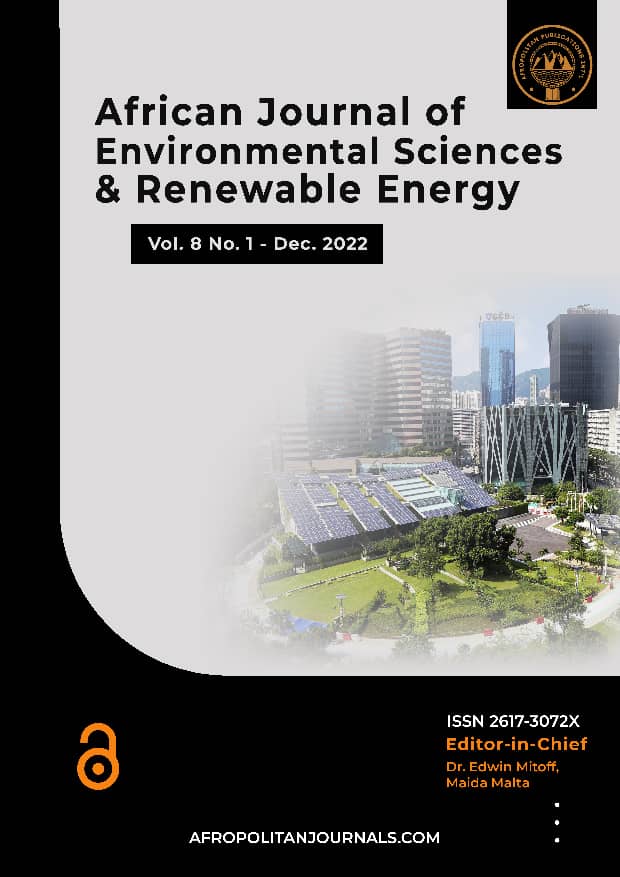Geochemical Analysis of Ground Water in Maiduguri and Its Environs of Borno State, North Eastern Nigeria
Main Article Content
Abstract
This research work is aimed at geochemical assessment of groundwater in Maiduguri and its environs to determine the physical and chemical characteristics of groundwater and its suitability for both domestic, industrial, and agricultural use. The method employed for this research includes geological collection of data from field which involves, (mapping, sampling of groundwater), and laboratory analysis on the samples obtained from the field to assess the status of some major and trace elements in the water samples which have direct impact on human health and can lead to diseases such as acute kidney disease and chronic kidney disease among inhabitants. Twenty three (23) samples were collected from hand pump wells and boreholes as well as tube wells. At each sample point the geographical coordinates was taken using a portable global positioning system (GPS) device. Water samples was also collected using a clean rubber container which was rinsed with a distilled water, after which the physical parameters like the TDS, EC, and temperature was determined at the point of sample collection while the chemical parameters was analyzed in Multi User science research laboratory (MUSRL) ABU Zaria to determine the concentration of some major and trace elements (Na, K, Ca, Pb, Cd, and F). The values obtained from both physical and chemical analysis were compared to those of world health organization (WHO), and Nigerian Standard for drinking water quality (NSDWQ). The concentration of Na ranges from14.00mg/l to 104mg/l and it falls within the permissible standard of 200mg/l, K values ranges from 2.3mg/l to 8.00mg/l and Ca values ranges from 3.999mg/l to 85.487mg/l while those of trace elements like Pb which has 0.0904mg/l, Cd has 0.045mg/l and F values ranges from 0.000025 to 0.000141 mg/l are higher than the required standard for drinking water and will pose health impact on human if there is continuous usage of the water from the study area and this can result to diseases such as renal failure, dental caries and insulin resistance. Therefore, water within the study area has to be treated so as to ascertain its suitability for drinking.
Downloads
Article Details

This work is licensed under a Creative Commons Attribution-NonCommercial-NoDerivatives 4.0 International License.
References
Carrard, N., Foster, T., & Willetts, J. (2019). Groundwater as a source of drinking water in southeast Asia and the Pacific: A multi-country review of current reliance and resource concerns. Water (Switzerland), 11(8).
Dinesh, P., & Rajesh, G. (2013). Study of Some Physicochemical Parameters of Drinking Water Sources in Tembhurkheda and Jarud Region Dist. Amravati, MS, India. International Research Journal of Environment Sciences, 2(10), 93–95.
Ishaku, J. M., Ankidawa, B. A., & Abbo, A. M. (2015). Groundwater Quality and Hydrogeochemistry of Toungo Area, Adamawa State, North Eastern Nigeria. American Journal of Mining and Metallurgy, 3(3), 63–73.
Jalo, M. E. N. (2015). Geology and petrography of the rocks around Gulani Area, Northeastern Nigeria. Journal of Geology and Mining Research, 7(5), 41–57.
Janardhana Rao, D., Swami, A. V. V. S., Raghu Babu, K., & Hari Babu, B. (2016). Water quality index using gis and suitability for drinking purpose in and around Badvel Taluka of Kadapa District, Andhra Pradesh, India. Rasayan Journal of Chemistry, 9(3), 444–453.
Kasidi, S and Victor, V. (2019) Groundwater Exploration Using Vertical Electrical Sounding (Ves) Method In Musawa And Environs Of Katsina State, Nigeria. IOSR Journal of Applied Geology and Geophysics (IOSR-JAGG) e-ISSN: 2321–0990, p-ISSN: 2321–0982.Volume 7, Issue 6, PP 73-83
Khwaja, M. A., Aggarwal, V., Bhattacharya, B., & Rout, C. (2017). Qualitative Assessment of Water Quality through Index Method: A Case Study of Hapur City, Uttar Pradesh, India. International Journal of Earth Sciences and Engineering, 10(02), 427–431.
Kwami, I. A., Ishaku, J. M., Bello, A. M., Yusuf, A., Abubakar, U., & Mukkafa, S. (2018). Assessment of Water Quality Index for the Groundwater in Gombe and Environs, North-east Nigeria. IOSR Journal of Applied Geology and Geophysics, 6(5), 29–37.
Nur, A., Ishaku, J. M., & Yusuf, S. N. (2012). Groundwater Flow Patterns and Hydrochemical Facies Distribution Using Geographical Information System (GIS) in Damaturu, Northeast Nigeria. International Journal of Geosciences, 03(05), 1096–1106.
Nwachukwu, C. C., Ugbor, C. C., & Ogboke, O. J. (2022). Electrical Resistivity Sounding for Groundwater Investigation around Enugu Metropolis and the Environs, Southeast Nigeria. International Journal of Geosciences, 13(01), 54–70.
Patrick, A., Cosmos, U. C., Uzo, E., & Raphael, G. (2015). Suitability Assessment of Shallow Groundwater of a Typical Coastal Aquifers for Irrigation Use; A Water Quality Index Model Approach. IOSR Journal of Mech. and Civil Engineering Ver. I, 12(6), 2278–1684.
Virtual, U., & Project, L. (2004). UNESCO VIRTUAL LABORATORIES PROJECT University of Maiduguri Focal Point Research Report.
Wang, J. (2012). Estimation of Phosphorus Bioavailability in the Water Column of the Bronx River, New York. Journal of Environmental Protection, 03(04), 316–323.
Zouahri, A., Dakak, H., Douaik, A., El Khadir, M., & Moussadek, R. (2014). Evaluation of groundwater suitability for irrigation in the Skhirat region, Northwest of Morocco. Environmental Monitoring and Assessment, 187(1), 1–15.

